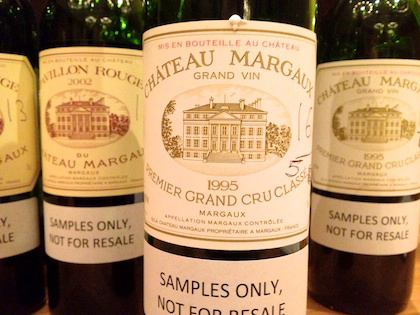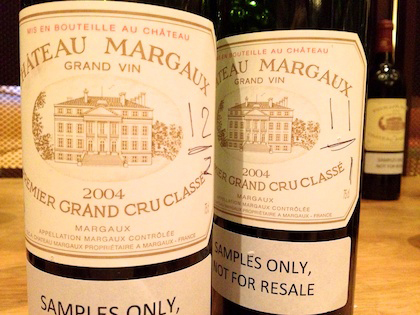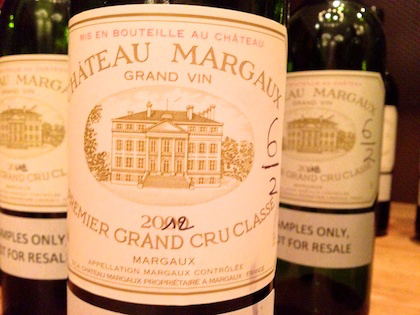Tasting Chateau Margaux 16 ways
Paul Pontallier is a curious, open, and humble guy. All the more so since he is he managing director and winemaker at Chateau Margaux, where he has been for 30 years, crafting the sublime yet supremely expensive wines.
Pontallier was in New York City last week and he brought suitcase full of treats to show off not just how his wines taste, but how his mind works. The wines poured included examples of each grape variety, pre blending, of the 2012 grand vin. While it’s rare for wineries to transport tank samples, I’ve never heard of top Bordeaux winery doing it, let alone a grand cru. (Tank samples are inherently young and tannic and they often don’t travel well, which is one reason top estates around the world prefer critics travel to them to taste young wines.) Pontallier also brought examples of various tests and trials they are doing at the winery, including wines that had be farmed Biodynamically, organically and conventionally. Further, he brought examples that had been fined and unfined, filtered and unfiltered, most interestingly, a pair of 2002s that were closed with both cork and screwcap.
I’m sure all the top wineries in Bordeaux do such experimentation. But few are as open with the results at Margaux; they’re also enshrining research and development in a new building designed by Sir Norman Foster at the center of the 650-acre estate.
As to the 2012 samples, they mostly conformed to expectations: the merlot was slightly smoky and surprisingly smooth, the cabernet had a lively acidity, and the petit verdot was burly with a hint of herbaciousness. There was also a sample of press wine, the most accessible and really quite a delicious wine in its own right. Pontallier said that it now accounts for 16-17% of the final blend, citing major improvements in the vinification of the press wine.
Next, six samples appeared in front of us–also poured blind–two each from the organic, Biodynamic, and conventional test vineyards, arrayed over two vintages, 2012 and 2011. Pontallier admitted that the test area was relatively small (2 ha.), had surprisingly varied soil, the fruit of the approximately 30-year-old vines was usually used for second- or third-label wines, and all the vines were in the same area, not buffered by the normal 75-ft setbacks that organic certification requires.
Pontallier described himself as being “very interested†in organic vinticulture for 25 years and he hasn’t used insecticide at Margaux for ten years. He’s performing a sustainable approach but trying to reduce the chemical sprays; in the soggy 2012 vintage, he was particularly pleased to have done only one spray in the vineyard of the whole estate and hasn’t used insecticides for ten years. He cited the overall environmental sustainability of the estate as his motivation. With regards to Biodynamics, he said that he comes from a “very scientific culture†and that “religion stops with a belief in God.†Yet he’s willing to give Biodynamics a try and to that end the estate has a Biodynamics consultant.
One counterintuitive thing Pontallier noticed in the test plots was that the insect diversity appeared greatest in the conventional area. In the glass, one wine in each flight stood out to me as being stinky or borderline flawed; in each case, it turned out to be the one from organically grown grapes. The other wines appeared broadly similar, bright and tight.
Next up for us was a comparison of fined and unfined grand vin wines from 2004. Pontallier said that fining “has a very positive effect on the stability of a wine†since it is a “wonderful way†to bring down levels of residual yeasts and bacteria. He added that it also brings smoothness to the finish of final wine; while it’s a matter of taste, he admitted that some unfined wines that receive high scores have a rough finish for him. (For all the linguists out there, he also dwelled for a moment on how prefers the English term “fining†since it focuses on the ultimate wine in the glass as opposed to the French term for the process, known as “collage,†focusing more an catching any unwanted items.)
Fining a wine is often done with egg whites and Margaux mostly uses five eggs to fine the wine in a 225-liter barrel. Or A/B tests had an unfined one and one that had been fined using six eggs (thus a bit more fine). I found the two wines to be broadly similar here, with similarly complex aromatics of leathery tobacco and red berry. On the finish, one wine was slightly smoother, and, per Pontallier’s remarks, it was the fined one.
Screwcaps vs corks was the next test and the wine here was the 2002 Pavillon Rouge. Pontallier said they had done four closure experiments here, with cork, two types of screwcaps (one more permeable than the other), and a synthetic cork. He said the synthetic cork failed miserably and spectacularly (he wouldn’t mention the manufacturer) leaving behind an oxidized mess of a wine. He poured us the screwcap wine from the least permeable screwcap. Overall, he said he is a real fan of screwcaps and that if he made a white wine meant to be consumed within six months he would “surely†use screwcaps. But he has to think 50 years into the future for his wines, and can’t take the risk right now on committing to screwcaps.
This was perhaps the most discernible difference in these last three pairs of wines. The first wine was slightly more evolved, making it better drinking today. The second wine was tighter, younger, fresher tasting almost, making it seem to need more time. I preferred the first but ten years’ hence, would that be the case? Who’s to know. The difficulty in determining the “better†wine was apparent as the show of hands in the room was evenly divided.
Our final pair was a real treat: two examples of the 1995 Chateau Margaux, one that had been filtered and one that was unfiltered. Sterile filtration combats Brettanomyaces, which is often (though not always) considered a fault in winemaking. But does it strip out something else in the wine? Pontallier says that racking the wine from one barrel to another can achieve a similar end; Margaux racks the wine four times in the first year and three times in the second. Racking and fining was all winemakers had before sterile filtration and Pontallier comes down on the old school side in this debate, not filtering the wine. I was surprised at the difference in the glass, though not as apparent as the cork/screwcap, one wine appeared more advanced than the other, which was really singing, redolent in leather and rose petals. The taste memory of that (unfiltered) wine lasted with me the rest of the day.
Overall, it was a terrifically informative tasting. I was pleased to have had the opportunity to taste the fruits of Potallier’s R&D—really, could there be a more pleasurable form of research? My only lament (besides not snapping a pic of the man himself for you), was the fact that I felt almost sorry for Bordeaux at the end of the tasting. The wines of Brdeaux have had a hard time gaining traction with sommeliers and other wine thought leaders recently. Mostly this is because of the price—that 1995 Margaux I tried fetches $500 on the market today and the current release is almost double. Some of the top wines from the region are stylistically divergent from what sommeliers seek and are more in line with wine speculators seek. The fragmented nature of sales (the Bordeaux place system on top of US distributors) can prevent a natural path to trade and press events for the chateaus. But the wines become a lot more interesting with tasting and discussion; Pontallier’s honesty, curiosity gentle humor (not to mention the wines) make him a terrific representative for the region.







On February 5th, 2013 at 9:40 am ,Jack Bulkin wrote:
Tyler, you didn’t invite me.
On February 5th, 2013 at 10:27 am ,Thomas Pellechia wrote:
Tyler,
Nice report.
The resistance (and rightly so) to the price of Bordeaux leaves me to wonder on whom these presentations are meant to make their mark?
On February 5th, 2013 at 9:18 pm ,RobinC wrote:
Very interesting and educational seminar. I also wonder who is the intended audience. As in, who is buying?
On February 5th, 2013 at 9:47 pm ,Jessica Fialkovich wrote:
Wow, all I can muster is jealous.
On February 5th, 2013 at 11:56 pm ,NMS wrote:
“This was perhaps the most discernible difference in these last three pairs of wines. The first wine was slightly more evolved, making it better drinking today. The second wine was tighter, younger, fresher tasting almost, making it seem to need more time. I preferred the first but ten years’ hence, would that be the case? Who’s to know. The difficulty in determining the “better†wine was apparent as the show of hands in the room was evenly divided.”
Wait, so which was under screwcap and which was under cork?
I’d guess the “fresher” one would be the screwcap one, but the writing doesn’t exactly say that.
On February 6th, 2013 at 8:35 am ,PhilippeN wrote:
Thank you Tyler for reporting on this. It is great to see Margaux reaching out to explain how they keep trying to learn and improve their wines. I am sure they feel an obligation to seek perfection given the stratospheric pricing that the market is willing to bear. This is an important point – the market has taken the prices up and clearly the top chateaux haven’t been embarrassed to accept this.
As for the comment about the pricing of ‘Bordeaux’ and on ‘whom these presentations are meant to make their mark’ it is important to note that Bordeaux is the largest single appellation in France and that there are hundreds of great value wines priced well below premium priced Napa reds that are worthy of our attention. So much press attention is paid to the top classed growths that for many this is ‘Bordeaux’. The truth is the quality consciousness across Bordeaux writ large (get to know the petits chateaux) continues to improve. The work of top chateaux such as Margaux continues to move the bar higher and we all benefit in the form of exceptional quality across the spectrum. Don’t miss the great 2009s and 2010s priced at retail for under 30 dollars. The quality and price are there for those willing to look a bit deeper. Bordeaux may be larger than they make us aware – and it is well worth broadening the perspective.
On February 6th, 2013 at 10:26 am ,Thomas Pellechia wrote:
Phillipe,
I am not questioning the petites chateaux of Bordeaux. I doubt, however, that Chateau Margaux pays all that money to send someone around the world with all that luggage to show us how the the rest of Bordeaux wines are doing…and while I fully understand that “the market” exists, prices are set by producers and shippers, not by consumers.
It’s always been the case that certain “named” wines have commanded lofty prices, but even a loft has a roof on it–until the roof is blown away by an indifferent storm.
On February 6th, 2013 at 12:15 pm ,“Tasting Chateau Margaux 16 Ways”: An Excellent Post on Dr Vino’s Blog | Flora's Table wrote:
[…] a very quick note to give heads up to our wine enthusiast readers as to an in my view excellent post that got published yesterday in Tyler Colman’s wonderful wine blog, Dr […]
On February 6th, 2013 at 12:15 pm ,“Tasting Chateau Margaux 16 Ways”: An Excellent Post on Dr Vino’s Blog « Clicks & Corks wrote:
[…] a very quick note to give heads up to our wine enthusiast readers as to an in my view excellent post that got published yesterday in Tyler Colman’s wonderful wine blog, Dr […]
On February 6th, 2013 at 5:14 pm ,PhilippeN wrote:
Thank you Tom. I would just define terms more clearly when referring to ‘Bordeaux’. There are a lot of winemakers working very hard for not much return and they should not fall prey to being bundled with the rarefied-air pricing of a small minority. I hope you can appreciate that perception sometimes turns into reality as the baby is thrown out with the bath water. As someone who works closely with the full spectrum of properties, I feel that we should recognize the good efforts of many. As for Margaux, I applaud their taking the time and money to openly discuss what they are doing. I believe that it is not only good marketing but also instructive to many. And I am sure they relish the opportunity to take feedback from the individuals that they invited to attend the tasting.
On February 13th, 2013 at 1:55 pm ,Nate wrote:
Great post! Question: how was the prominence of the Brett on the unfiltered vs the filtered?
On February 13th, 2013 at 2:37 pm ,Dr. Vino wrote:
Nate – great question. I really thought the unfiltered one would be Bretty and that was what I was looking for in the blind pairing. But neither was, which was odd.